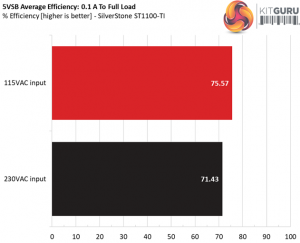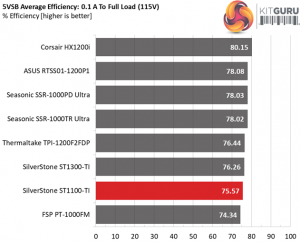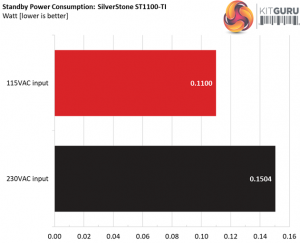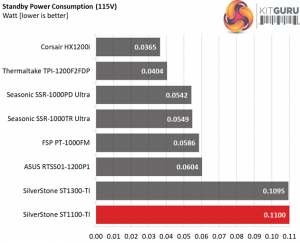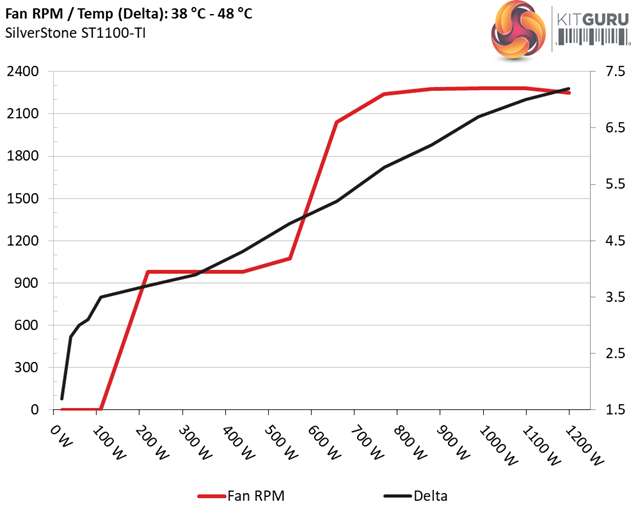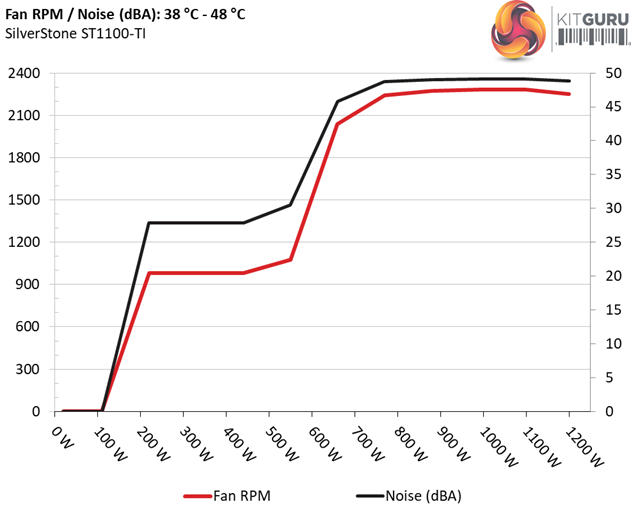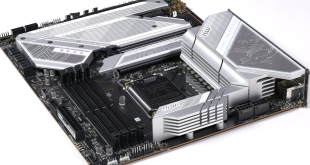Efficiency
Our efficiency testing procedure is detailed here.
Using results from the previous page, we plotted a chart showing the ST1100-TI’s efficiency at low loads, and loads from 10 to 110 percent of its maximum-rated capacity.
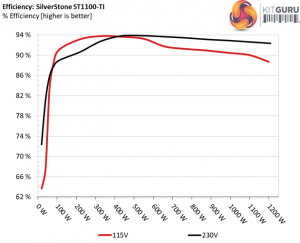
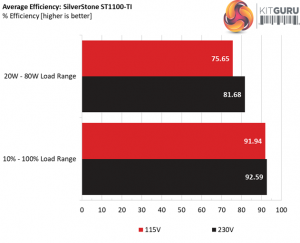
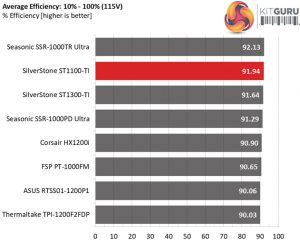
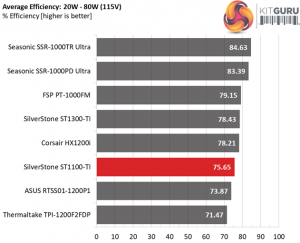
With normal loads the ST1100-TI only loses to the superb Seasonic Prime Titanium, which has 100W less capacity. The efficiency levels are not so impressive though under light loads, where SilverStone's offering comes in third place from bottom.
Efficiency At Low Loads
In the following tests, we measure the ST1100-TI's efficiency at loads significantly lower than 10 percent of its maximum capacity (the lowest load the 80 PLUS standard measures). The loads we dial are 20, 40, 60, and 80W. This is important for representing when a PC is idle, with power-saving features turned on.
| Test # | 12V | 5V | 3.3V | 5VSB | DC/AC (Watts) | Efficiency | Fan Speed (RPM) | PSU Noise (dB[A]) | PF/AC Volts |
| 1 | 1.202A | 0.491A | 0.476A | 0.196A | 19.683 | 63.650% | 0 | <6.0 | 0.821 |
| 12.157V | 5.069V | 3.340V | 5.061V | 30.924 | 115.08V | ||||
| 2 | 2.428A | 0.980A | 0.986A | 0.396A | 39.769 | 67.593% | 0 | <6.0 | 0.898 |
| 12.156V | 5.066V | 3.336V | 5.052V | 58.836 | 115.06V | ||||
| 3 | 3.651A | 1.476A | 1.499A | 5.042A | 59.875 | 83.162% | 0 | <6.0 | 0.926 |
| 12.164V | 5.063V | 3.333V | 5.042V | 71.998 | 115.06V | ||||
| 4 | 4.868A | 1.975A | 1.979A | 0.793A | 79.768 | 88.205% | 0 | <6.0 | 0.933 |
| 12.160V | 5.060V | 3.330V | 5.032V | 90.435 | 115.07V |
The efficiency levels during the first two tests are very low, showing that Enhance should probably adjust the burst mode of the LLC resonant converter, in order to achieve higher efficiency levels under such light loads.
5VSB Efficiency
The ATX specification (revision 1.4), along with CEC, ErP Lot 3 2014 and ErP Lot 6 2010/2013, states that the 5VSB standby supply efficiency should be as high as possible, recommending 75 percent or higher with 550mA, 1A, and 1.5A of load.
The supply should also achieve higher than 75% efficiency at 5VSB under full load, or with 3A if its max current output on this rail is higher than 3A.
We take six measurements: one each at 100, 250, 550, 1000, and 1500mA, and one with the maximum load the 5VSB rail can handle.
| Test # | 5VSB | DC/AC (Watts) |
Efficiency | PF/AC Volts |
| 1 | 0.102A | 0.506 | 67.919% | 0.038 |
| 4.970V | 0.745 | 115.01V | ||
| 2 | 0.252A | 1.252 | 74.925% | 0.083 |
| 4.963V | 1.671 | 115.01V | ||
| 3 | 0.543A | 2.686 | 76.765% | 0.165 |
| 4.951V | 3.499 | 115.02V | ||
| 4 | 1.002A | 4.945 | 80.302% | 0.263 |
| 4.933V | 6.158 | 115.02V | ||
| 5 | 1.502A | 7.378 | 81.841% | 0.341 |
| 4.912V | 9.015 | 115.02V | ||
| 6 | 3.002A | 14.547 | 79.137% | 0.475 |
| 4.846V | 18.382 | 115.01V |
The 5VSB rail is not that efficient, when compared to other high-end platforms at least.
Power Consumption In Idle And Standby
In the table below, you’ll find the power consumption and voltage values of all rails (except -12V) when the PSU is idle (powered on, but without any load on its rails), and the power consumption when the unit is in standby mode (without any load, at 5VSB).
| Mode | 12V | 5V | 3.3V | 5VSB | Watts | PF/AC Volts |
| Idle | 12.159V | 5.071V | 3.343V | 5.071V | 7.871 | 0.342 |
| 115.1V | ||||||
| Standby | 0.109 | 0.006 | ||||
| 115.0V | ||||||
The vampire power levels are increased, with both 115V and 230V input. This affects of course the 5VSB rail's efficiency under very light loads.
Fan RPM, Delta Temperature, And Output Noise
Our mixed noise testing is described in detail here.
The first chart below illustrates the cooling fan's speed (in RPM), and the delta between input and output temperature. The results were obtained at 38°C (100.4°F) to 48°C (118.4°F) ambient temperature.
The next chart shows the cooling fan's speed (again, in RPM) and output noise. We measure acoustics from one meter away, inside a hemi-anechoic chamber. Background noise inside the chamber is below 6 dB(A) during testing (it's actually much lower, but our sound meter’s microphone hits its floor), and the results are obtained with the PSU operating at 38°C (100.4°F) to 48°C (118.4°F) ambient temperature.
The following graph illustrates the fan's output noise over the PSU's operating range. The same conditions of the above graph apply to our measurements, though the ambient temperature is between 30°C (86°F) to 32°C (89.6°F).
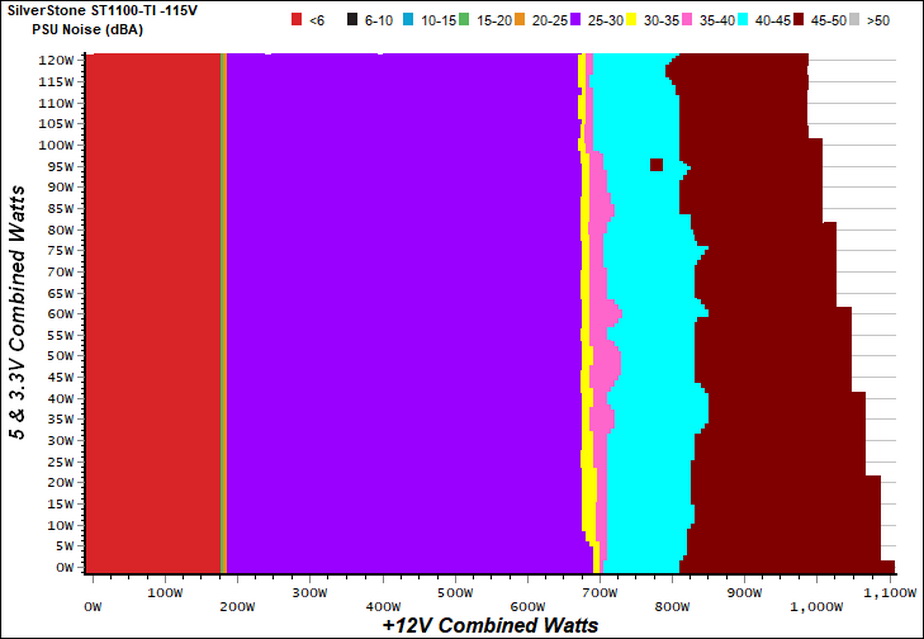
The semi-passive mode doesn't last long and as the graph above shows, it doesn't take into account the load on the minor rails but only the load at +12V. Up to 690W the noise is within the 25-30 dB(A) range but with loads exceeding 700W, it climbs above 40 dB(A).
Finally, with over 810W load +12V you will probably need ear plugs to cope with the noise as it exceeds 45 dB(A). This is a shame because this platform is highly efficient, so the fan speed profile could be tuned better to allow for a much quieter operation, especially at high loads.
Be sure to check out our sponsors store EKWB here
 KitGuru KitGuru.net – Tech News | Hardware News | Hardware Reviews | IOS | Mobile | Gaming | Graphics Cards
KitGuru KitGuru.net – Tech News | Hardware News | Hardware Reviews | IOS | Mobile | Gaming | Graphics Cards


